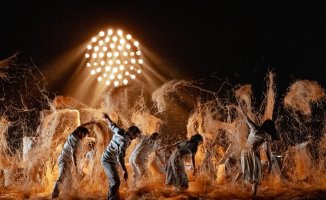The just ended 2023 has once again been a very dry year in Barcelona and other places in Catalonia, especially in the eastern half. The Fabra Observatory in Barcelona, which belongs to one of the oldest institutions in the city, the Royal Academy of Sciences and Arts of Barcelona (RACAB), has returned to totaling, after two years, in 2021 and 2022, also very dry, little more than 300 mm of precipitation.
Specifically, 309.5 mm, a figure that is only slightly more than half of the average recorded by the Observatory (611.8 mm). A quantity such as the one mentioned is comparable to the normal values of many places in the south-east of the Iberian Peninsula or the region of Monegres, very dry geographical areas, with landscapes that reveal a pronounced aridity.
The value of the annual precipitation places 2023 as the second driest year in the 110-year rainfall series, from 1914, when meteorological records began at the Fabra Observatory, to the present day.
But the highlight is the concatenation of the three driest years, 2021 with 327.6 mm, 2022 with 307.7 mm and 2023 with the amount quoted. Randomly, the occurrence of the three driest years in a row in the 110 series has a very low probability. In meteorology, it is called an ephemeris, that is, a meteorological event relevant for its climatological, historical or anecdotal value.
If, in addition, the three driest years are required to occupy the end of the series, as it happens, the probability is minuscule. All this has resulted in an exceptional drought with a very long return period. This has led to a hydrological drought expressed by the meager percentages of water stored in the reservoirs of the internal basins of Catalonia, with respect to their maximum capacity, below 17% at the beginning of 2024, without a previous benchmark.
The scarcity of water, in turn, has given rise to an agricultural or edaphic drought, due to its effect on the land and the countryside, and also to an ecological drought, with severe effects on some ecosystems. And, finally, we have entered a period of socio-economic drought, because a good number of economic sectors and daily activities are affected by the decrease in available flows.
The current situation, due to the recent concatenation of the three driest years, allows, from a climatological point of view, to affirm that the annual precipitation in Barcelona already shows a negative trend, that is, towards a statistically significant reduction?
To answer this question, statistical tests of trends are used, of which the most universal is the Mann-Kendall non-parametric test.
In any case, when this test is applied to the entire series, and also to the last 100 years, 30, 25 and 20, it cannot be said that there is a negative trend in the annual rainfall in the Catalan capital. However, if we consider a series with a length of approximately 50 years that ends in 2023, that is to say, beginning in the seventies, the aforementioned test admits that in the last half century the precipitation in Barcelona it shows a statistically significant downward trend, with a confidence level of 95% in some cases (for example, for the 53-year period 1971-2023).
This is so because some of the years of the aforementioned decade, that is to say, of the beginning of the period, were particularly rainy, such as 1971, the rainiest since there have been records at the Fabra Observatory, with 1,122.5 mm , and at the other end, the last three have been the driest.
The alleged pluviometric shortage of the last three years in Barcelona, and also in other cities of Catalonia, is even more serious due to the fact that the last two years have been, at the Fabra Observatory, the warmest since its inception, something that can be explained largely due to global and regional warming.
On an annual scale, one could speak of a combined dry and warm episode ( compound dry-hot event ), today the subject of cutting-edge research in climatology in the case of heat waves that take place in a period of drought .













